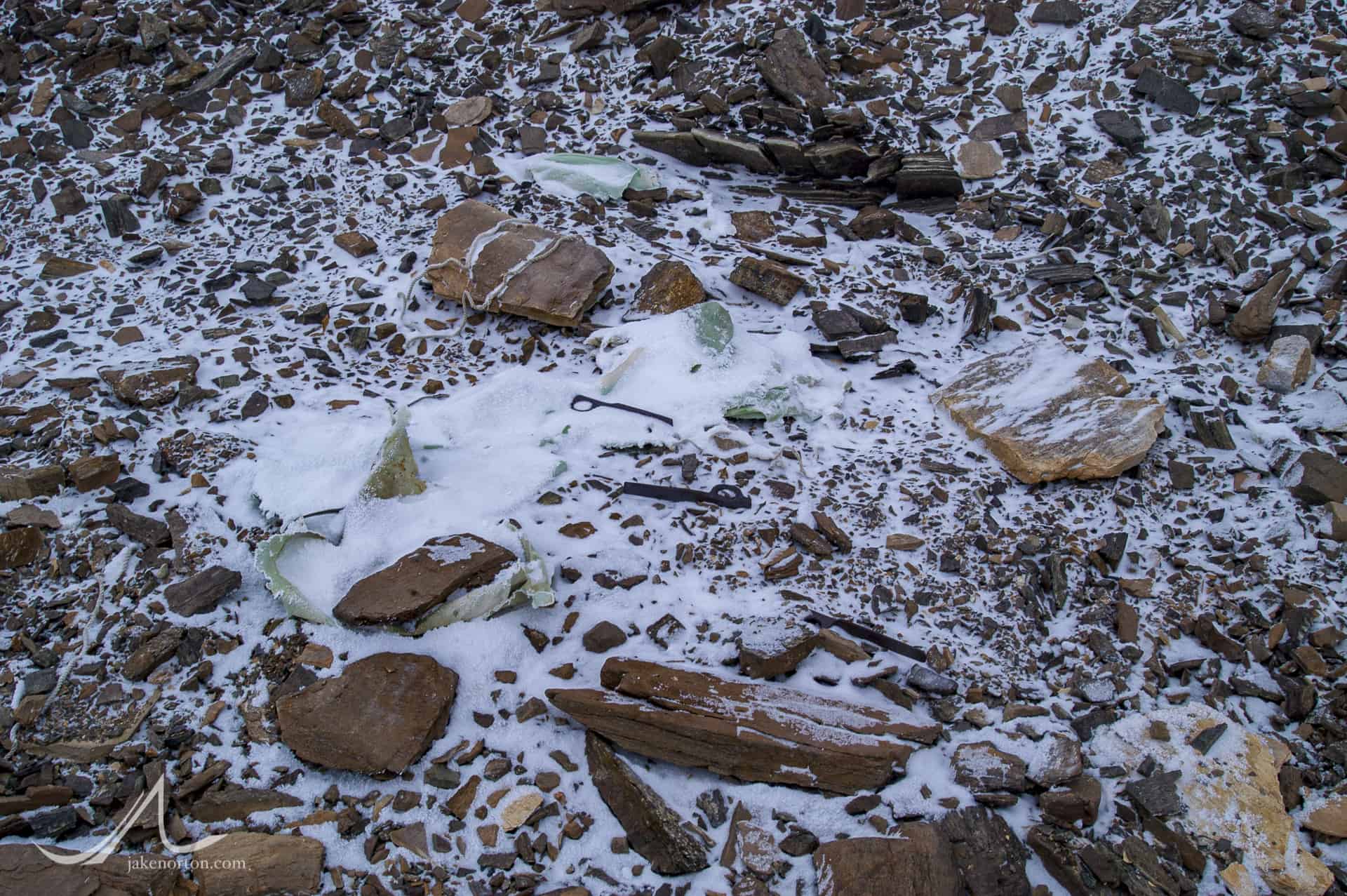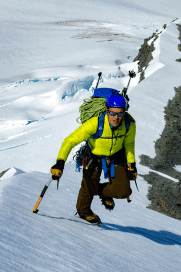Back in 2004 on the third Mallory & Irvine Research Expedition, Dave Hahn and I scoured the upper mountain looking for traces of Mallory & Irvine from 80 years before. I have posted videos from this expedition in the past, here and here.
After a couple days of searching on our second round working about 27,000 feet, Dave and I decided it was time for him to make a summit bid. Having reached the top the two previous years, I had little interest in climbing to the summit again and chose to let Dave go with our stellar Sherpa team of Danuru and Tashi. I would remain high on the mountain in support and do some additional searching.
My target for the day was multi-fold. I wanted to head to the Northeast Shoulder of Everest, due north of our high camp at 27,300 feet, and:
- get a look at the famed Pinnacles where Peter Boardman and Joe Tasker disappeared in 1982
- check out the Longland Traverse used by the British in the pre-World War II climbs
- see firsthand what the Yellow Band would have looked like for Mallory & Irvine back in 1924 approaching it from their high camp on the North Ridge
- and see if I could locate the remains of the 1938 Camp VI
The day was far from perfect – the wind howled, blowing frigid snow into my down suit and knocking me over as I left our tents.
As I moved across the terrain of the North Face, my excitement built. Ever since I was a little kid, I’ve always had a fascination with history, with finding bits of the past long forgotten. Although the weather was not ideal, I had a good feeling about the day and was happy to be off route, away from the fixed lines, going where very few venture.
The climbing to the NE Shoulder is not tough – scree slopes and snow gullies wind up a 35 degree angle. The hard part is simply the reality of scree climbing: one step forward lands you two steps back. Not a fun thing anywhere, but especially not at 27,300 feet! But, my excitement for the day propelled me forward.
Eventually I gained the NE Shoulder…and the full force of the wind as it howled across the North Face and out onto the Tibetan Plateau. I scrambled around trying to think of where I would pitch a glorified pup-tent back in 1938. No place made sense at all, but I finally saw a small wind-break in the rock and moved toward it. As I did, I got distracted by something long and thin in the rubble to the west and, upon investigation, found a full length wooden tent pole.
Bingo. It had to be from 1938, the camp must be nearby. Since I had walked downwind to get to the tent pole, I figured the pole must have blown there and thus the tent site would be upwind. Heading back, I b-lined to the rocky windbreak I saw before, and, sure enough, lying under a dusting of snow were the remains of the 1938 Camp VI.
After scouring through the meager remains of the camp, I took a more thorough look around – the mighty Pinnacles loomed above and the Longland Traverse, obvious as an interstate cutting through the Yellow Band, headed off diagonally some 200 meters away.
I could just envision Mallory & Irvine here 80 years before climbing upward toward the as-yet-unclimbed summit of Everest. The adventure and trepidation they must have felt was almost palpable. The mountain may yet yield their mysteries…but not that day.
It had already been 4 hours for my outing on the ridge, and I knew from radio conversations that Dave, Danuru, and Tashi were coming down from a successful – but windy – summit day.
As I always do, I knelt down and said my private words of thanks to Chomolungma, Sagarmatha, the mountain deities, for sharing the terrain, the experience, the adventure with me, and I walked happily back to camp.



Dear Jake,
I had a good look at this 1938 campsite area in recent days and I for one thank you for airing it.
Most illuminating (even if the weather wasn’t).
I’m struck by how exposed the terrain is up there and well understand the problems Shipton & Smythe and Tilman & Lloyd had up there.
Having read ‘Everest 1938’ by Tilman last year, I was fascinated to read his account of how LLoyd was able to reach ’38 Camp VI 1/2 and hour before Tilman, with and without o2 respectively.
Comparison with M&I revealed
LLoyd had the speed to reach
’38 Camp VI and erect the meade tent before Tilman arrived.
LLoyds o2 kit was heavier than the Irvine MK V kit and yet from ’38 Camp V he climbed at a rate of about 350 vert feet hour CF Tilman
311 vert ft/hr.
They departed Camp V at 25800ft just after 8.00am and LLoyd reached 27,200 ft < 4 hours with Tilman arriving at 12.30pm with his lower climb rate. I plotted Lloyds climb rate and compared it to the point when he was parallel to M&I '24 camp VI. It indicates Lloyd passed 26,700 ft about 2.5 hours after starting (thats about 10.30am) and from there reached 27,200 ft about 1.5 hours later using heavier kit too!. I believe there are lessons for us here in determining M&I climb rate out of '24 Camp VI with lighter o2 and perhaps more of a 'spring in their fresher step' compared to Lloyds heavier kit and more fatigue after 2.5h or climbing. I tend to think M&I went up skyline to the ridge close to the T&L route so to catch the suns warmth as early as possible and then ridge hopped in the sun having gotten the steeper climbing over early on. Less time in the shadowy YB eh!. Thus I'm very interested in the '38 route as I suspect M&I went close by this area. If 350 vert feet/hr was matched, then M&I would have reached '38 Camp VI site after 1.5 hours (but thats assuming 2.2L/min rate like LLoyd's. This would still leave just over 2.1h of o2 left to climb the remaining 600 ft to reqch the #9 o2 cylinder at about 27,800 ft. At a rate of 350 vert/ft/hr, this is quite likely and allowing for the greater speed on the 'flats of the ridge crest leading from the 'twin crags' to the #9 cylinder site. Very nice. Thus I think this '38 campsite area is most interesting. I'm keen to learn more of the Longland route or access routes up from '38 Camp VI to the ridgecrest. I suspect M&I went that way. NO cylinders will be found in this area as its too early in the climb, but I wonder about discarded tins of lollies, mintcake etc. You never know..... Thanks again Jake for airing this material. Good health to you, Phil
hi.. just looking through your video.. great that you put this on the net.. just a note.. i know the sound track repeats it self.. but one of the things you picked up and described as something to do with the oxygen kit.. it to me looks like the tool you use to remove the nozle of the old primus/optimus stoves.. important kit in those days as the fuel they used was often locally obtained.. and sooty, so blocked the jets of the cookers often, without heat for water they would be stuffed..
anyway great website.. wish the video was abit clearer!
cheers
Ant
Great video. Thanks for all your work, from all of us who will never get there.
Thanks, Mike, glad you enjoyed it!